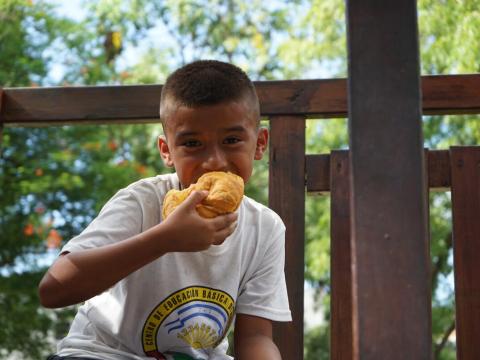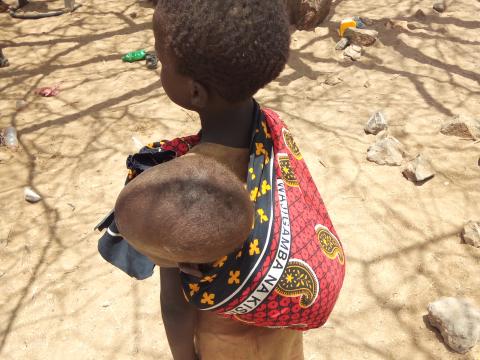
The Seven Things You May Not Expect in a Hunger Crisis
Micah Branaman dives into the heart of the hunger crises, sharing insights gathered from World Vision's frontline response.
I am not a food specialist or a health expert, but in my role leading communications for World Vision’s Global Hunger Response, I have learnt a lot about the reality and different faces of childhood hunger from my colleagues who are authorities on the subject. Here are a few of the unexpected lessons they’ve shared with me over the past year and a half:

1. Hungry children don’t always look the way you’d expect
Most children suffering severe malnutrition will be extremely skinny, experiencing severe muscle wasting (thinning of muscle mass) and have a very low weight for their height.
However, it may surprise you to learn that a dangerously hungry child doesn’t always appear skeletal. Their ailing body may also look puffy, with a lack of proper nutrients and protein causing swollen feet, face, and limbs, due to a condition called Kwashiorkor.
World Vision’s Colleen Emary, a Senior Technical Advisor in Health and Nutrition, says it’s not a common form of malnutrition, but its prevalence spikes when people experience famine-like conditions and hunger crises.
“We don't understand why some children who are severely, acutely malnourished, develop a thin skeletal appearance, and others develop oedema, which is a build-up of fluid,” she says. “It starts in their feet and legs, and then it spreads up to their face and their hands. It’s a fatal condition if left untreated.”
2. A starving child may lose their appetite
A growling tummy and irritability are typical signs we think of when a hungry child has missed a meal or two. But as malnutrition progresses, a child will often lose their appetite.
“It isn't as simple as saying ‘OK, this child's hungry, but they don't have access to food . . . so let’s give them food’”, says Emary. “It's not linear like that. A child who is severely, acutely malnourished will often lose their appetite for many reasons, such as illness, to which they are more susceptible due to the impact malnutrition has on their immune system."
Children suffering from extreme malnutrition are at a much higher risk of contracting diseases and the underlying infections, such as diarrhoeal disease and acute respiratory infection, are often what leads lack of appetite. Addressing these diseases as part of their overall nutrition management plan helps restore appetites for most children.
But even once they begin to recover and feel hungry again, food must be slowly reintroduced as the sickest and most malnourished children’s stomachs can’t tolerate normal food. Starting with a life-saving peanut-based paste called ready-to-use therapeutic food (also known as RUTF) ensures that children suffering from severe acute malnutrition can gain weight quickly and begin to recover as they receive essential micronutrients.

3. Hungry children don’t always sound the way you’d expect
Have you ever heard a hungry child cry? No doubt you’ve felt the urge to spring to their side, to feed and comfort them. But a baby crying from starvation makes a different sound altogether, says World Vision’s Global Hunger Response Director, Mary Njeri.
“It’s a deep, strangling wail that’s excruciating to hear,” she says. “What’s even worse is when babies go quiet. You know they no longer have the strength to cry, because their fragile bodies are shutting down.”
She says at this point they need immediate therapeutic treatment, which World Vision provides at health centres across the globe. “We can save every malnourished child – but sadly there is not enough funding as our pleas are falling on deaf ears,” she says.
4. The astonishing generostiy of the hungriest people
It’s often those with the least who give the most, Njeri says as she recalls one story in particular that she’ll never forget.
At a food distribution Njeri visited in Kenya, she fondly remembers a woman she met who had 10 mouths to feed at home with their monthly ration.
“The rations this lady had accounted for about 70% of the food her family would need for the month,” she says. “So, there was already an inadequate amount of food for them. But then we learnt that four women had come to her home so she could share her rations with them as well. And she did this without thinking twice.”
After sharing the rations that could have lasted her family four weeks with her neighbours, she now had just enough to last her family for 10 days, but such is the generosity of spirit Njeri says she sees played out so often.

5. The Asian countries where even rice has become a luxury
Even when food is hard to come by, there’s always rice, right? Wrong.
Rice production is drastically down due to climate-induced disasters, such as drought, uneven monsoon rains in India, and floods in Pakistan, in addition to a rise in fertiliser prices, have affected supply. India, the world’s largest exporter, also restricted rice exports last year to safeguard a domestic supply. This has led to the global price of rice to jump to its highest in a decade, affecting more than 3.5 billion people in 150 countries around the world.
Consequently, parts of Asia, the region that consumes 90% of the world’s rice, face the unthinkable situation of people being unable to afford rice, says Terry Ferrari, World Vision’s regional leader in East Asia.
“Rice is a staple of many in East Asia . . . but it is becoming out of reach for many poor families,” she says.
Between 40%–67% of a person’s daily caloric intake comes from rice in top rice consuming countries, like Bangladesh, Bhutan, Cambodia, Indonesia, Thailand, and Sri Lanka. Yet, a typical Cambodian has to work for 4.5 days to afford a food basket of 10 common food items, including 1 kilogramme of rice. A Sri Lankan has to spend 2 days of earnings, a Bangladeshi must work for 1.5 days to buy the food basket, and an Indonesian has to spend a days’ worth of wages, compared to just 1.5 to 2 hours of work in Australia, Canada, Ireland, Singapore, the US, and the UK.
6. Hunger alone doesn’t kill
Rather, people die from deadly, but preventable and curable, diseases. After being hungry for months on end, their immune systems can’t fight infectious diseases, such as cholera, diarrhoea, malaria, measles, and pneumonia.
The sad truth is that children suffering from wasting – the most life-threatening form of undernutrition in early childhood – are 11 times more likely to die of disease than a well-nourished child. However, only 20% of the children who require life-saving treatment for wasting receive it, leading 1 million children to die unnecessarily every year.
Right now, 45 million children are suffering from this crisis stage of hunger.

7. Now for the good news . . . Hunger can be solved
food security and climate intelligence project in Mulwani, Democratic Republic of Congo (DRC) that was designed to increase agricultural production and teach climate-smart practices. / © World Vision
It may seem insurmountable, but the tools do exist to solve world hunger. And World Vision has them. But there’s much more work to be done.
“We need to address the root causes, such as what alternative livelihoods we can support in areas affected by years of drought,” says Njeri. “We need to work with these communities to help them not just in the next three months or six months, but in the next two years, to get them out of this.”
In October 2023, the organisation launched Phase 2 of our Global Hunger Response with our largest-ever appeal – US$2.5 billion – to curb the hunger crisis for 30 million of the most vulnerable people in 28 countries facing unprecedented levels of hunger, malnutrition, and other long-lasting health issues and harmful indirect impacts – by providing life-saving food assistance, clean water, emergency health and nutrition services, as well as protection and resilience-building activities alongside our recently launched global ENOUGH campaign aiming to end child hunger and malnutrition.
Micah Branaman is currently deployed as the Advocacy & Communications Senior Advisor for the Middle East Crisis Response from her role as Communications Technical Director for World Vision's Global Hunger Response. Learn more about World Vision's Middle East Crisis Response here and Global Hunger Response here.

